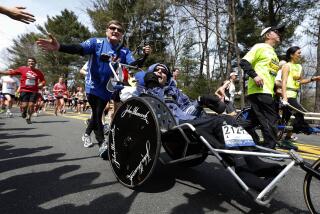In Fixx’s Case, Genes Overtook Exercise
- Share via
In the summer of 1984, Jim Fixx appeared very much in his prime. The author of the 1977 bestseller “The Complete Book of Running” had transformed himself from an overweight, chain-smoking young man into an exemplar of good health--and inspired millions to do the same. He was running 10 miles a day. He was playing tennis. He was 52, famous and very fit.
And one Friday, while traveling in Vermont, he decided to go for a run. On the afternoon of July 20, Fixx set out from a motel where he was staying--and never returned. A motorcyclist found his body lying beside Route 15 in Hardwick later that day. Soon doctors had determined the cause of death: heart failure. The autopsy exam showed that three of Fixx’s coronary arteries were damaged by arteriosclerosis, and one was almost completely blocked.
The irony of the death was lost on no one. Skeptics of Fixx’s jogging gospel said the man was a victim of his own compulsion, that in the end it was the running that had killed him. Others dismissed the man and the message in one breath. “A lot of people heard the news and said, ‘Aha, I told you so, I knew the running wasn’t doing much good,’” says Amby Burfoot, winner of the 1968 Boston Marathon and now executive editor of Runner’s World magazine.
Yet doctors who had followed Fixx’s career saw a more complex picture. It was clear, for instance, that Fixx had a strong family history of heart disease: His father had a heart attack at 35 and died of another one at 43. It was not clear how closely the younger Fixx had been monitoring his own cardiovascular health. If he had any warning of a heart condition, his former wife told the New York Times, he ignored it.
Dr. Tom Bassler, a California pathologist and acquaintance of Fixx, said the author had been planning to get examined. “I recall that he’d been scheduled to have a treadmill test that very next week,” Bassler said in an interview.
If he’d had the exam earlier, it could have saved his life, doctors say. A physician who detected evidence of advanced arteriosclerosis might have put Fixx on medication or even recommended a bypass operation, either of which could have extended his life. “Jim Fixx was running against his genes, and today we would put him on statin drugs and watch him very closely,” says Dr. Nancy Lane, a UC San Francisco rheumatologist who studies the effects of exercise.
Speculation aside, doctors say the larger lesson of Fixx’s death has to do with the limitations of exercise as the key to long life.
On the one hand, the author outlived his father by almost 10 years.
On the other, “his death demonstrated that just because you’re in good shape doesn’t mean that other things are not going to get you,” said Dr. Jonathan Chang, an orthopedic surgeon, former competitive runner and professor at USC. “You cannot completely outrun your inheritance.”
Ask Alberto Salazar. At 43, the former world record-holder in the marathon and two-time Olympian is on cholesterol medication and watching his blood pressure. “Even running 40 miles a week, like I do, I still have to pay attention to these things,” he said. “There’s a family history there.”


